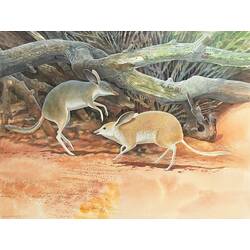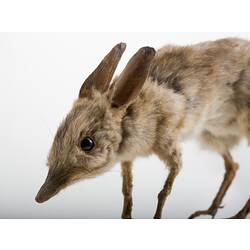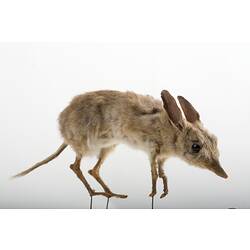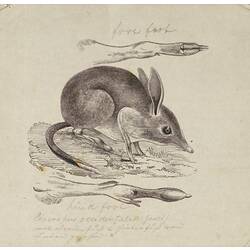Pig-footed bandicoots once occurred across much of the sandy deserts and grasslands of Australia. These little bandicoots were incredibly unusual, as they walked on two toes on their front legs and just one toe on their hind legs.
In 2019, a team of researchers led by the Western Australian Museum and the Natural History Museum in London, discovered a new species of Pig-footed bandicoot here within the collections of Museums Victoria. Dr Kenny Travouillon, Curator of Mammalogy at the WA Museum, said the discovery of Chaeropus yirratji is a breakthrough for science as little was known about the mammal previously.
"Pig-footed Bandicoots were extinct by the 1950s, therefore there was very little chance for scientists to study the species. More so, there are only 29 specimens of Pig-footed Bandicoots in existence. In comparison, there are more than 800 specimens of the extinct Thylacine, or Tasmanian Tiger, in museum collections," Dr Travouillon said.
The new species was discovered during research into the 29 specimens of Pig-footed Bandicoot held in museums across the world, with 16 of those in the Mammal collection of Museums Victoria. Scientists had thought all the specimens were of the same species, Chaeropus ecaudatus. By using a combination of traditional morphology, morphometrics, palaeontology and molecular phylogenetics, they discovered there were in fact two different species. DNA from specimens collected in 1846 confirmed the existence of two species not only morphologically, but genetically.
"Although very similar, the two species have some distinct differences," Dr Travouillon said. "Chaeropus yirratji has fewer holes in its palate compared to Chaeropus ecaudatus and it has different shaped teeth, suggesting different diets. Chaeropus yirratji also has much longer feet, meaning it would have been able to take longer strides and therefore move faster."
Aboriginal oral accounts recorded in the 1980s, as well as some fossil data were important in tracing the two species' distributions and understanding their ecology. Yirratji was the Warlpiri name used in these accounts, and was used by the scientists to name the new species. Chaeropus yirratji was thought to have lived in sandy environments in central Australia and Chaeropus ecaudatus lived in the southern peripheral areas of the arid zone of Australia. Both species were thought to inhabit areas of Western Australia.
Aboriginal people from the western deserts reported that the Yirratji inhabited sandplains and dunes with spinifex and tussock grass, sometimes with a mulga overstorey and lived in a grass-lined nest in a scrape during the day time. They said that Yirratji ran or scampered and did not hop. It ran too fast for people to catch, and when chased by dogs it would often run into a hollow log.
Unfortunately, scientific knowledge of this new species arrives too late to save it from extinction. However, this research highlights the importance of museum collections in understanding present and past biodiversity in Australia.
Dr Travouillon agrees that without museums and collections, discovering new species of animals, especially extinct animals, wouldn't be possible.
"The Pig-footed Bandicoot is one of more than 30 mammal species that have gone extinct in Australia since European colonisation. By conducting this research and identifying new species we're able to better understand the impact of our actions so we can prevent the extinction of more amazing animals in the future."
More Information
-
Keywords
-
Authors
-
Article types





